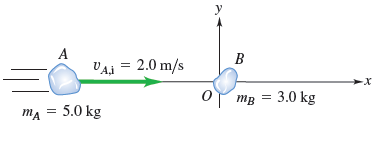This is a two-dimensional version of a conservation-of-momentum problem. Now we will have to keep track of both the x and y components of the momentum of each object in the system. (Figure 1) shows two chunks of ice sliding on the surface of a frictionless frozen pond. Chunk A, with mass mA=5.0kg, moves with initial velocity vA,i=2.0m/s parallel to the x axis. It collides with chunk B, which has mass mB=3.0kg and is initially at rest. After the collision, the velocity of A is found to be vA,f=1.0m/s in a direction at an angle α=30∘ with the initial direction (Figure 2). What is the final velocity of B (magnitude and direction)? PART A. b)If chunk B has an initial velocity of magnitude 1.6 m/s in the +y direction instead of being initially at rest, find the final magnitude of its velocity. c)Using Part A, find the final direction of the velocity.
This is a two-dimensional version of a conservation-of-momentum problem. Now we will have to keep track of both the x and y components of the momentum of each object in the system. (Figure 1) shows two chunks of ice sliding on the surface of a frictionless frozen pond. Chunk A, with mass mA=5.0kg, moves with initial velocity vA,i=2.0m/s parallel to the x axis. It collides with chunk B, which has mass mB=3.0kg and is initially at rest. After the collision, the velocity of A is found to be vA,f=1.0m/s in a direction at an angle α=30∘ with the initial direction (Figure 2). What is the final velocity of B (magnitude and direction)?
PART A. b)If chunk B has an initial velocity of magnitude 1.6 m/s in the +y direction instead of being initially at rest, find the final magnitude of its velocity.
c)Using Part A, find the final direction of the velocity.

Trending now
This is a popular solution!
Step by step
Solved in 7 steps with 1 images






